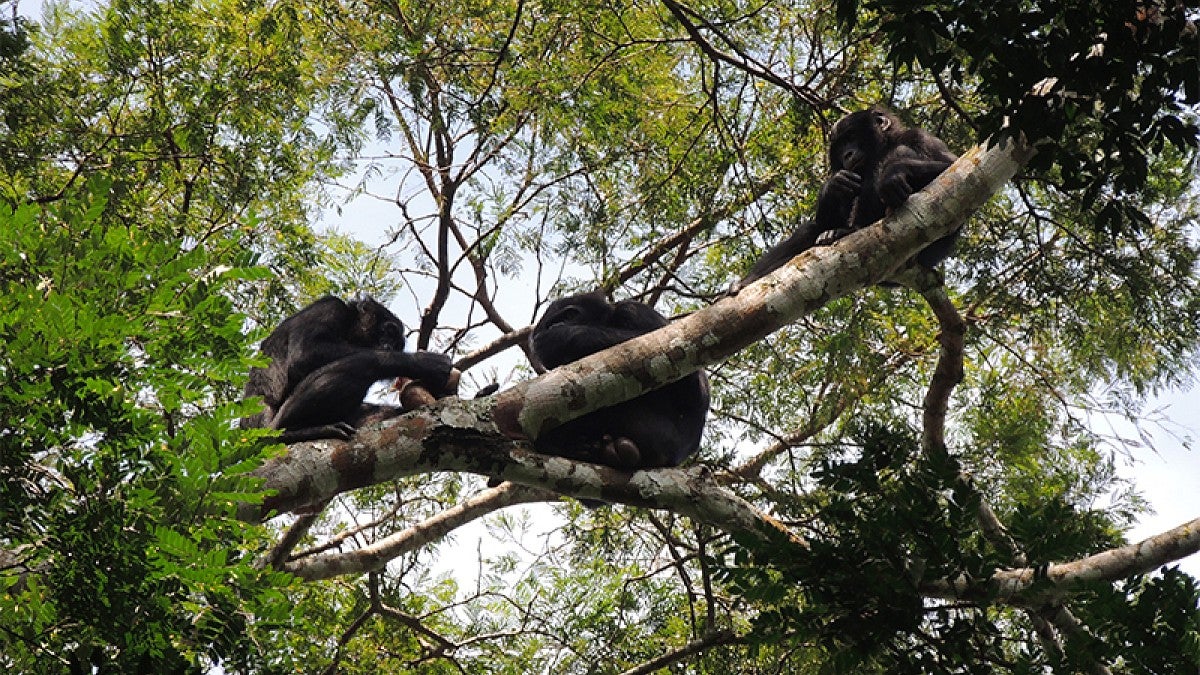In an African forest where leopards and poisonous mamba dwell, a University of Oregon team once had to flee charging boar. But it was a brief detour in research that adds to the idea that bonobos are neither hippies nor vegans.
For six months in 2017, the team, including local guides and colleagues from Northern Kentucky University, hiked a 9-square-mile area of the Lomako Forest in the Democratic Republic of the Congo. Their goal was to solidify the idea that bonobos, a female-dominated ape species, eat meat more often than previously believed.
The research effort — funded by the Leakey Foundation and National Geographic Society — paid off.
“Bonobos are a type of chimpanzee, and we are continuing to assess the differences between these different species,” said UO doctoral student Colin Brand. “We are finding a lot of similarities and some key differences. Meat-eating seems to be a similar behavior of both species in terms of the rate at which they do it.”
Chimps have a broad range in Africa, but bonobos live only in the forest along the big bend of the Congo, the world’s ninth-longest river.
While bonobos are known to eat monkeys, some birds and hyrax, their preferred food in the region studied was Weyn’s duikers – small antelope easily carried along the ground and up onto tree branches.
In the journal Folia Primatologica, the team documented that bonobos capture and consume meat at the same frequency as male-dominated chimpanzees. They also found that females control the duiker carcasses and get aggressive when other bonobos, especially males, reach for a handout but that they also show tolerance and will share with subadult males.
In one instance, an adult male tried to retain control of a carcass by clutching it in its arms and running away from a group, said Alexana J. Hickmott, a UO doctoral student. In another, a female protecting a carcass punched a persistently begging young male in the face with a closed fist.
Most research on the evolution of food consumption and sharing among apes has focused on chimps. Study co-author Frances White, a UO anthropologist who has studied bonobos in the Congo since 1983, had seen such behavior but had not focused on it.
Meat-eating was directly witnessed on three occasions and inferred on two others, one based on finding feces filled with duiker hair and witnessing bonobos fleeing a carcass.
Bonobo fecal matter also attracts the region’s two species of boars. During a June outing, researchers ran or climbed trees as five red-river hogs charged and struck, without seriously injuring, two team members.
“We were there when the boars’ babies were being born, so the males can get defensive,” Hickmott said. “Red-river hogs are abundant. We were getting ready to collect fecal samples, heard people yelling and saw them sprinting past us. We had to flee.”
While some team members returned to camp, others resumed their search for bonobos in the area.
Meat preferences appear to vary across habitats, possibly driven by broken or heavy forest and maybe reflecting the cultures of separate bonobo populations, said White, who heads the Department of Anthropology and is curator of primate osteology at the UO’s Museum of Natural and Cultural History.
“People often think of bonobos as hippy apes, that they make love not war,” she said. “That’s fine at some level, but it also is a gross miscategorization. In general, it doesn’t pay to be aggressive for bonobos, but when it does they can be just as aggressive as chimps.
“It depends on where they are at,” she said. “Bonobos will attack humans, but people don’t like to hear that. People want to hear that bonobos are kind, are sweet and much like animals that we have domesticated. But that’s not true. Some of the nastiest fights seen have been among bonobos.”
This similar behavior by chimps and bonobos, which diverged from a common ancestor almost 2 million years ago, is surprising some researchers, White said.
“It’s interesting that bonobos do these behaviors and at a rate similar to chimps,” said Hickmott, a New Mexico native who is studying bonobo microbiomes to track the evolution of their dietary changes. “But you also see variation across bonobo sites in both meat-consumption and meat-sharing. To understand the behavioral variation, we need to know more about how these behaviors differ across locations.”
Brand is focusing on similarities and differences in bonobos that are based on phenotype — behaviors, morphology and physiology — and their genetics.
“I grew in Columbus, Ohio, which has one of only seven zoos in the United States that have captive populations of bonobos,” he said. “I knew what a bonobo was before I knew what a chimp was. I’ve always been interested in them.”
Co-authors with Brand, Hickmott and White were Monica Wakefield, Ian Takaoka and Lindsey Meador, all of Northern Kentucky University, and Michel Waller, who earned a doctorate from the UO and is now affiliated with the UO anthropology department and Central Oregon Community College in Bend.
Brand was additionally supported by a Global Oregon Graduate Research Award from the Global Studies Institute in the UO’s Division of Global Engagement.
—By Jim Barlow, University Communications


